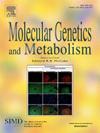Differentiation of neonatal and infantile onset ECHS1 deficiency using SCEH enzyme activity and plasma acylcarnitine analysis
IF 3.5
2区 生物学
Q2 ENDOCRINOLOGY & METABOLISM
引用次数: 0
Abstract
Mitochondrial short-chain enoyl-CoA hydratase 1 deficiency (ECHS1D) is an autosomal recessive disorder that presents in the neonatal or infantile period with encephalopathy and lactic acidosis. Biomarkers are variable, with many ECHS1D patients having elevated plasma C4-carnitine and urine 2-methyl-2,3-dihydroxybutyric acid while others have none. Neonates often succumb prior to molecular sequencing results being returned. ECHS1D diagnosis may be faster if biomarkers are used in plasma and urine along with enzyme activity measurement. Short-chain enoyl-CoA hydratase activity was performed in six ECHS1D fibroblasts with neonatal or infantile onset. DBS cards were obtained from two patients and one carrier. Control fibroblasts (n = 11) activity was 229.62 ± 68.52 nmol/min/mg. Neonatal ECHS1D fibroblasts activity was 3.92 ± 0.62 nmol/min/mg. Infantile onset ECHS1D fibroblasts activity was 17.27 ± 2.14 nmol/min/mg. Control DBS SCEH activity was 141.18 ± 34.00 nmol/min/mg (n = 10) and one neonatal and infantile patient sample showed approximately 2 % and 27 % activity, respectively. One carrier had 45 % activity. We described five new cases of ECHS1D and analyzed seven total cases. We determined SCEH activity reference ranges in neonatal and infantile onset ECHS1D fibroblasts. For the first time, we demonstrated SCEH activity in DBS with separation between ECHS1D and controls. SCEH activity in DBS could allow for newborn screening for ECHS1D as new treatments are developed.
Synopsis
Neonatal and infantile onset ECHS1D can be differentiated via fibroblast and dried blood spot short-chain enoyl-CoA hydratase activity and detection of plasma S-(2-carboxypropyl)cysteine carnitine species to allow for faster diagnosis and prompt treatment.
用SCEH酶活性和血浆酰基肉碱分析鉴别新生儿和婴儿发病的ECHS1缺乏症
线粒体短链烯酰辅酶a水合酶1缺乏症(ECHS1D)是一种常染色体隐性遗传病,出现在新生儿或婴儿时期伴有脑病和乳酸酸中毒。生物标志物是可变的,许多ECHS1D患者血浆c4 -肉碱和尿2-甲基-2,3-二羟基丁酸升高,而其他患者则没有。新生儿经常在分子测序结果返回之前死亡。如果在血浆和尿液中使用生物标志物以及酶活性测量,ECHS1D的诊断可能会更快。在6例新生儿或婴儿发病的ECHS1D成纤维细胞中检测短链烯酰辅酶a水合酶活性。从两名患者和一名携带者获得了DBS卡。对照成纤维细胞(n = 11)活性为229.62±68.52 nmol/min/mg。新生儿ECHS1D成纤维细胞活性为3.92±0.62 nmol/min/mg。婴儿期ECHS1D成纤维细胞活性为17.27±2.14 nmol/min/mg。对照组DBS SCEH活性为141.18±34.00 nmol/min/mg (n = 10), 1例新生儿和1例婴儿患者样品分别显示约2%和27%的活性。一种载体的活性为45%。我们描述了5例新的ECHS1D病例,并分析了7例病例。我们确定了新生儿和婴儿发病的ECHS1D成纤维细胞的SCEH活性参考范围。我们首次在ECHS1D与对照分离的DBS中证实了SCEH的活性。随着新的治疗方法的开发,DBS中的SCEH活性可能允许新生儿筛查ECHS1D。新生儿和婴儿发病的ECHS1D可以通过成纤维细胞和干血斑点短链烯酰辅酶a水合酶活性和检测血浆S-(2-羧丙基)半胱氨酸肉碱种类来区分,以便更快地诊断和及时治疗。
本文章由计算机程序翻译,如有差异,请以英文原文为准。
求助全文
约1分钟内获得全文
求助全文
来源期刊

Molecular genetics and metabolism
生物-生化与分子生物学
CiteScore
5.90
自引率
7.90%
发文量
621
审稿时长
34 days
期刊介绍:
Molecular Genetics and Metabolism contributes to the understanding of the metabolic and molecular basis of disease. This peer reviewed journal publishes articles describing investigations that use the tools of biochemical genetics and molecular genetics for studies of normal and disease states in humans and animal models.
 求助内容:
求助内容: 应助结果提醒方式:
应助结果提醒方式:


